Numerical Simulations of Magnetohydrodynamics Natural Convection and Entropy Production in a Porous Annulus Bounded by Wavy Cylinder and Koch Snowflake Loaded with Cu–Water Nanofluid
Abstract
:1. Introduction
2. Physical Model Description
- Thermal equilibrium is postulated between the base fluid and the nanoparticles. Moreover, there is no slip effect between the copper nanoparticles and water.
- The flow is considered to be incompressible, continuous, 2D, and laminar.
- Newtonian nanofluid.
- Except for the density in the body force component, which is approximated using the Boussinesq approximation, the fluid parameters are assumed to remain constant throughout the simulation.
- Heat transmission by radiation is disregarded.
- The effects of Joule heating, viscous dissipation, and displacement currents are deemed insignificant.
3. Mathematical Modeling
3.1. Governing Equations
3.2. Boundary Conditions
4. Numerical Methodology, Validation, and Mesh Evaluation
5. Results and Discussion
6. Conclusions
- Creating a higher intensity flow in the annulus by raising the Rayleigh number results in boosted free convective flow in the enclosure, which accelerates the heat transfer and the irreversibility due to fluid friction.
- Due to the unique shape of the heated Koch snowflake, nanofluid becomes trapped between the angled portions, causing the temperature distribution in these locations to be irregular and have a higher value.
- The cavity’s produced irreversibility is influenced by the decline in Da number, lower Da numbers cause the intensification of temperature in hot regions and a decrease in fluid velocity. By increasing the Da value, heat is transferred more equally across the flow layers and increases the entropy production due to fluid friction.
- At the highest studied Re number, decreasing the Da number from 10−2 to 10−5 resulted in magnifying Beavg by 18 times.
- Due to the direction of the magnetic field, applying Lorentz’s force decreases the average Nusselt number; however, this impact was less noticeable for lower Rayleigh numbers than at higher ones.
- At the highest studied Re number, Nuavg was enhanced by 100% when the Ha number was decreased from 100 to 0, while it was increased by 200% when the Da number increased from 10−5 to 10−2.
Author Contributions
Funding
Acknowledgments
Conflicts of Interest
Abbreviations
| List of symbols | ||
| Cp | Heat capacitance (J kg−1 K−1) | |
| g | Gravity (m s−2) | |
| Ha | Hartmann number | |
| Nu | Nusselt number | |
| p | Pressure (Nm−2) | |
| P | Dimensionless pressure | |
| Pr | Prandtl number | |
| R | Base circular radius of the block (m) | |
| Ra | Rayleigh number | |
| T | Dimension temperature (K) | |
| u, v | Dimensional velocity components along x and y directions (m s−1) | |
| U, V | Non-dimensional velocity components along with x and y directions | |
| x, y | Cartesian coordinates (m) | |
| X, Y | Non-dimensional coordinates | |
| Greek symbols | ||
| A | Thermal diffusivity (m2 s−1) | |
| β | Thermal expansion coefficient (K−1) | |
| k | Thermal conductivity (W m−1K−1) | |
| μ | Dynamic viscosity, kg m−1 s | |
| υ | Kinematic viscosity (m2 s−1) | |
| ρ | Density (kg m−3) | |
| ϕ | Volume fraction of the nanoparticles | |
| θ | Non-dimensional temperature | |
| Subscripts | ||
| C | Cold | |
| h | Hot | |
| F | Fluid | |
| P | Solid particles | |
| S | Solid block | |
| Avg | Average | |
References
- Chen, X.; Zhao, T.; Zhang, M.-Q.; Chen, Q. Entropy and entransy in convective heat transfer optimization: A review and perspective. Int. J. Heat Mass Transf. 2019, 137, 1191–1220. [Google Scholar] [CrossRef]
- Mourad, A.; Aissa, A.; Mebarek-Oudina, F.; Al-Kouz, W.; Sahnoun, M. Natural convection of nanoliquid from elliptic cylinder in wavy enclosure under the effect of uniform magnetic field: Numerical investigation. Eur. Phys. J. Plus 2021, 136, 429. [Google Scholar] [CrossRef]
- Rasheed, H.U.; Islam, S.; Khan, Z.; Khan, J.; Mashwani, W.K.; Abbas, T.; Shah, Q. Computational analysis of hydromagnetic boundary layer stagnation point flow of nano liquid by a stretched heated surface with convective conditions and radiation effect. Adv. Mech. Eng. 2021, 13, 16878140211053142. [Google Scholar] [CrossRef]
- Medebber, M.A.; Aissa, A.; Slimani, M.E.A.; Retiel, N. Numerical Study of Natural Convection in Vertical Cylindrical Annular Enclosure Filled with Cu-Water Nanofluid under Magnetic Fields. Defect Diffus. Forum 2019, 392, 123–137. [Google Scholar] [CrossRef]
- Rasheed, H.U.; Islam, S.; Zeeshan; Khan, J.; Abbas, T.; Mohmand, M.I. Numerical solution of chemically reactive and thermally radiative MHD Prandtl nanofluid over a curved surface with convective boundary conditions. J. Appl. Math. Mech./Z. Angew. Math. Mech. 2021, e202100125. [Google Scholar] [CrossRef]
- Rasheed, H.U.; Islam, S.; Helmi, M.M.; Alsallami, S.A.M.; Khan, Z.; Khan, I. An Analytical Study of Internal Heating and Chemical Reaction Effects on MHD Flow of Nanofluid with Convective Conditions. Crystals 2021, 11, 1523. [Google Scholar] [CrossRef]
- Kumar, P.; Sarviya, R. Recent developments in preparation of nanofluid for heat transfer enhancement in heat exchangers: A review. Mater. Today Proc. 2021, 44, 2356–2361. [Google Scholar] [CrossRef]
- Slimani, R.; Aissa, A.; Mebarek-Oudina, F.; Khan, U.; Sahnoun, M.; Chamkha, A.J.; Medebber, M.A. Natural convection analysis flow of Al2O3-Cu/water hybrid nanofluid in a porous conical enclosure subjected to the magnetic field. Eur. Phys. J. Appl. Phys. 2020, 92, 10904. [Google Scholar] [CrossRef]
- Al-Kouz, W.; Aissa, A.; Koulali, A.; Jamshed, W.; Moria, H.; Nisar, K.S.; Mourad, A.; Abdel-Aty, A.H.; Khashan, M.M.; Yahia, I.S. MHD darcy-forchheimer nanofluid flow and entropy optimization in an odd-shaped enclosure filled with a (MWCNT-Fe3O4/water) using galerkin finite element analysis. Sci. Rep. 2021, 11, 22635. [Google Scholar] [CrossRef]
- Amani, M.; Amani, P.; Bahiraei, M.; Ghalambaz, M.; Ahmadi, G.; Wang, L.-P.; Wongwises, S.; Mahian, O. Latest developments in nanofluid flow and heat transfer between parallel surfaces: A critical review. Adv. Colloid Interface Sci. 2021, 294, 102450. [Google Scholar] [CrossRef]
- Sheremet, M.A.; Pop, I. Natural convection in a horizontal cylindrical annulus filled with a porous medium saturated by a nanofluid using Tiwari and Das’ nanofluid model. Eur. Phys. J. Plus 2015, 130, 107. [Google Scholar] [CrossRef]
- Mebarek-Oudina, F.; Bessaïh, R. Numerical simulation of natural convection heat transfer of copper-water nanofluid in a vertical cylindrical annulus with heat sources. Thermophys. Aeromech. 2019, 26, 325–334. [Google Scholar] [CrossRef]
- Shahsavar, A.; Salimpour, M.R.; Saghafian, M.; Shafii, M.B. Effect of magnetic field on thermal conductivity and viscosity of a magnetic nanofluid loaded with carbon nanotubes. J. Mech. Sci. Technol. 2016, 30, 809–815. [Google Scholar] [CrossRef]
- Siavashi, M.; Jamali, M. Erratum to: Optimal selection of annulus radius ratio to enhance heat transfer with minimum entropy generation in developing laminar forced convection of water-Al2O3 nanofluid flow. J. Central South Univ. 2017, 24, 2486. [Google Scholar] [CrossRef] [Green Version]
- Al-Rashed, A.A.A.A.; Hassen, W.; Kolsi, L.; Oztop, H.F.; Chamkha, A.J.; Abu-Hamdeh, N. Three-dimensional analysis of natural convection in nanofluid-filled parallelogrammic enclosure opened from top and heated with square heater. J. Central South Univ. 2019, 26, 1077–1088. [Google Scholar] [CrossRef]
- Mirzaie, M.; Lakzian, E. Natural convection of nanofluid-filled annulus with cooled and heated sources and rotating cylinder in the water near the density inversion point. Eur. Phys. J. Plus 2021, 136, 834. [Google Scholar] [CrossRef]
- Boulahia, Z.; Boulahia, C.; Sehaqui, R. Three-Dimensional (3D) Visualization and Two-Dimensional (2D) Second Law Analysis of Magnetohydrodynamic (MHD) Free Convection Inside Cubical Enclosure Packed with Hybrid Nanofluid Containing a Circular Heating Cylinder: Effect of Inclined Magnetic Field. Arab. J. Sci. Eng. 2021, 46, 2985–2999. [Google Scholar] [CrossRef]
- Aljabair, S.; Mohammed, A.A.; Alesbe, I. Natural convection heat transfer in corrugated annuli with H2O-Al2O3 nanofluid. Heliyon 2020, 6, e05568. [Google Scholar] [CrossRef]
- Miles, A.; Bessaïh, R. Heat transfer and entropy generation analysis of three-dimensional nanofluids flow in a cylindrical annulus filled with porous media. Int. Commun. Heat Mass Transf. 2021, 124, 105240. [Google Scholar] [CrossRef]
- Asiaei, S.; Zadehkafi, A.; Siavashi, M. Multi-layered Porous Foam Effects on Heat Transfer and Entropy Generation of Nanofluid Mixed Convection inside a Two-Sided Lid-Driven Enclosure with Internal Heating. Transp. Porous Media 2018, 126, 223–247. [Google Scholar] [CrossRef]
- Seyyedi, S.M.; Dogonchi, A.S.; Ganji, D.D.; Hashemi-Tilehnoee, M. Entropy generation in a nanofluid-filled semi-annulus cavity by considering the shape of nanoparticles. J. Therm. Anal. Calorim. 2019, 138, 1607–1621. [Google Scholar] [CrossRef]
- Bouzerzour, A.; Djezzar, M.; Oztop, H.F.; Tayebi, T.; Abu-Hamdeh, N. Natural convection in nanofluid filled and partially heated annulus: Effect of different arrangements of heaters. Phys. A Stat. Mech. Its Appl. 2020, 538, 122479. [Google Scholar] [CrossRef]
- Hu, Y.-P.; Li, Y.-R.; Lu, L.; Mao, Y.-J.; Li, M.-H. Natural convection of water-based nanofluids near the density maximum in an annulus. Int. J. Therm. Sci. 2020, 152, 106309. [Google Scholar] [CrossRef]
- Motlagh, S.Y.; Golab, E.; Sadr, A.N. Two-phase modeling of the free convection of nanofluid inside the inclined porous semi-annulus enclosure. Int. J. Mech. Sci. 2019, 164, 105183. [Google Scholar] [CrossRef]
- Cao, Y.; Ayed, H.; Togun, H.; Shawabkeh, A.; Dahari, M.; Wae-Hayee, M.; Mouldi, A.; Marzouki, R. Heating a cold semi-annulus wall by MHD natural convetion with nanofluid. Case Stud. Therm. Eng. 2021, 28, 101569. [Google Scholar] [CrossRef]
- Dogonchi, A.S.; Hashim. Heat transfer by natural convection of Fe3O4-water nanofluid in an annulus between a wavy circular cylinder and a rhombus. Int. J. Heat Mass Transf. 2019, 130, 320–332. [Google Scholar] [CrossRef]
- Dogonchi, A.S.; Nayak, M.K.; Karimi, N.; Chamkha, A.J.; Ganji, D.D. Numerical simulation of hydrothermal features of Cu–H2O nanofluid natural convection within a porous annulus considering diverse configurations of heater. J. Therm. Anal. Calorim. 2020, 141, 2109–2125. [Google Scholar] [CrossRef]
- Hadidi, H.; Mousavi, S.M.; Ghalambaz, M. Numerical study of MHD natural heat transfer of non-Newtonian, carbon nanotube-water nanofluid inside an internally finned annulus. Eur. Phys. J. Plus 2021, 136, 960. [Google Scholar] [CrossRef]
- Seyyedi, S.M.; Dogonchi, A.S.; Nuraei, R.; Ganji, D.D.; Hashemi-Tilehnoee, M. Numerical analysis of entropy generation of a nanofluid in a semi-annulus porous enclosure with different nanoparticle shapes in the presence of a magnetic field. Eur. Phys. J. Plus 2019, 134, 268. [Google Scholar] [CrossRef]
- Sheikholeslami, M.; Gorji-Bandpy, M.; Ganji, D.D.G.-D.; Soleimani, S. MHD natural convection in a nanofluid filled inclined enclosure with sinusoidal wall using CVFEM. Neural Comput. Appl. 2014, 24, 873–882. [Google Scholar] [CrossRef]
- Gupta, Y.; Rana, P. MHD natural convection in inclined wavy annulus utilizing hybrid nanofluid with discrete wavy coolers. J. Therm. Anal. 2021, 143, 1303–1318. [Google Scholar] [CrossRef]
- Tayebi, T.; Öztop, H.F.; Chamkha, A.J. MHD natural convection of a CNT-based nanofluid-filled annular circular enclosure with inner heat-generating solid cylinder. Eur. Phys. J. Plus 2021, 136, 150. [Google Scholar] [CrossRef]
- Gomez, A. Thermal Performance of a Double-Pipe Heat Exchanger with a Koch Snowflake Fractal Design; Georgia Southern University: Statesboro, GA, USA, 2017. [Google Scholar]
- Meyer, J.; Van Der Vyver, H. Heat Transfer Characteristics of a Quadratic Koch Island Fractal Heat Exchanger. Heat Transf. Eng. 2005, 26, 22–29. [Google Scholar] [CrossRef]
- Iftikhar, N.; Rehman, A.; Sadaf, H. Theoretical investigation for convective heat transfer on Cu/water nanofluid and (SiO2-copper)/water hybrid nanofluid with MHD and nanoparticle shape effects comprising relaxation and contraction phenomenon. Int. Commun. Heat Mass Transf. 2021, 120, 105012. [Google Scholar] [CrossRef]
- Umavathi, J.; Ojjela, O.; Vajravelu, K. Numerical analysis of natural convective flow and heat transfer of nanofluids in a vertical rectangular duct using Darcy-Forchheimer-Brinkman model. Int. J. Therm. Sci. 2017, 111, 511–524. [Google Scholar] [CrossRef]
- Sofiah, A.; Samykano, M.; Pandey, A.; Kadirgama, K.; Sharma, K.; Saidur, R. Immense impact from small particles: Review on stability and thermophysical properties of nanofluids. Sustain. Energy Technol. Assess. 2021, 48, 101635. [Google Scholar] [CrossRef]
- Jamshed, W. Numerical investigation of MHD impact on Maxwell nanofluid. Int. Commun. Heat Mass Transf. 2021, 120, 104973. [Google Scholar] [CrossRef]
- Sheikholeslami, M.; Shehzad, S. Simulation of water based nanofluid convective flow inside a porous enclosure via non-equilibrium model. Int. J. Heat Mass Transf. 2018, 120, 1200–1212. [Google Scholar] [CrossRef]

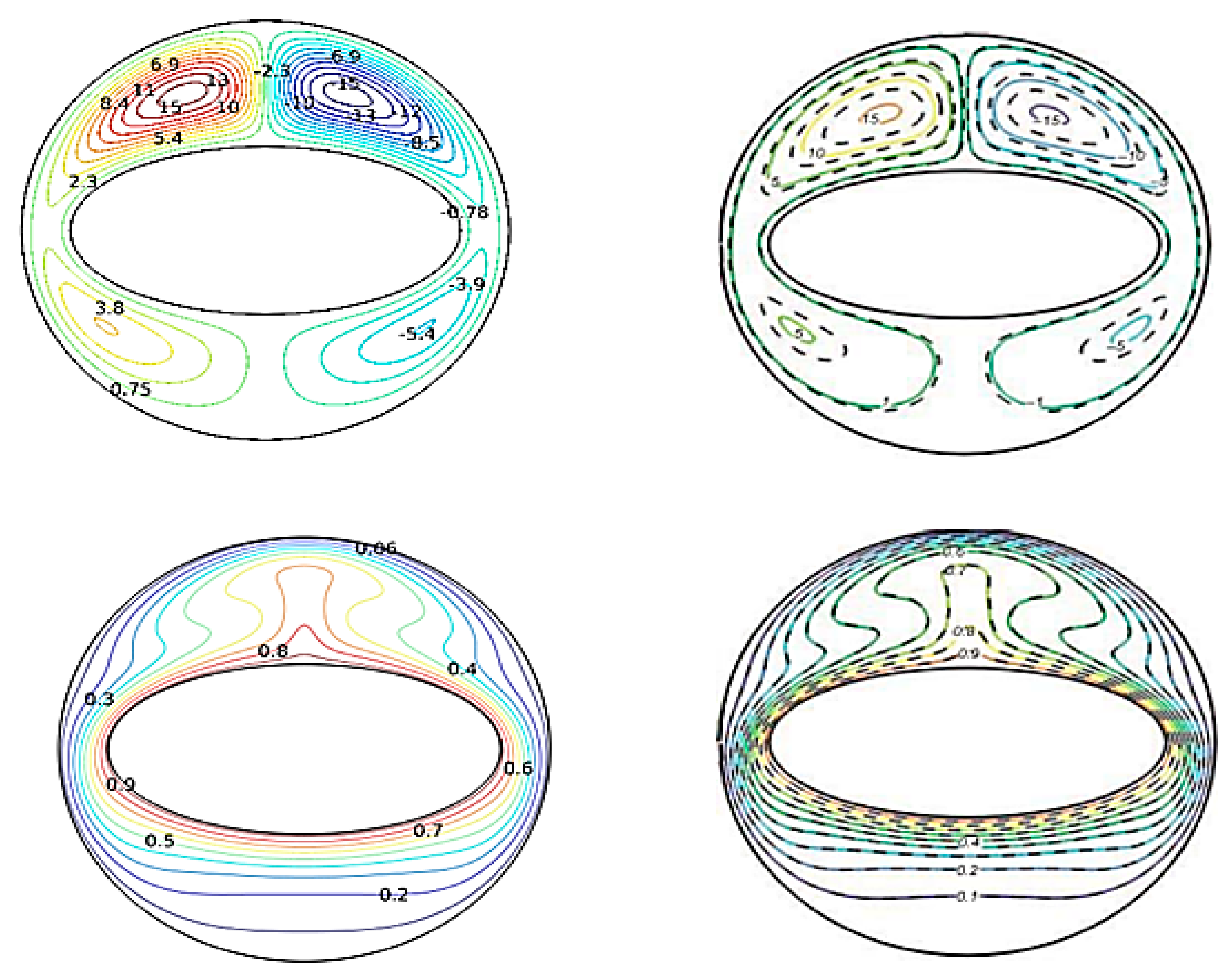
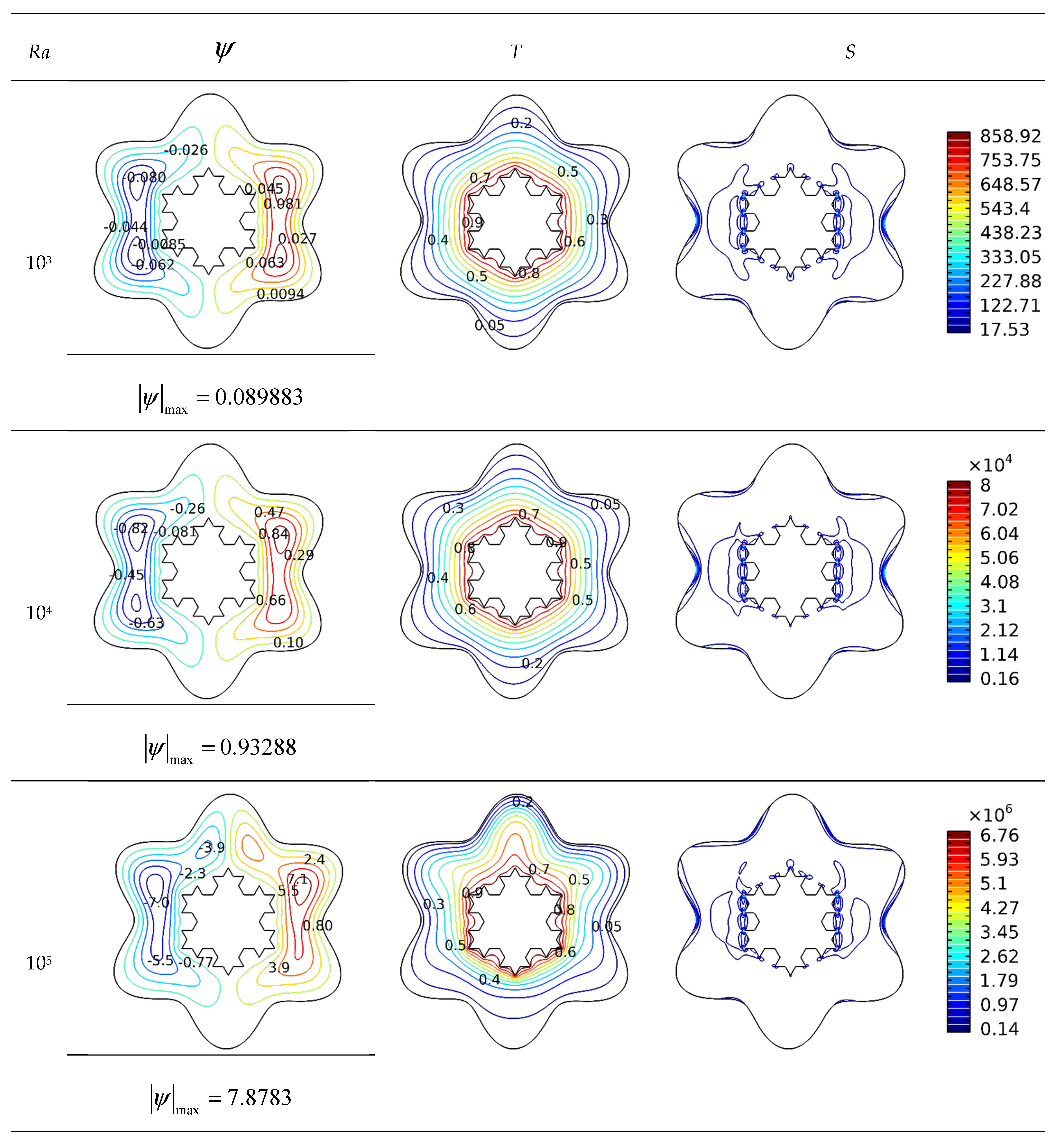
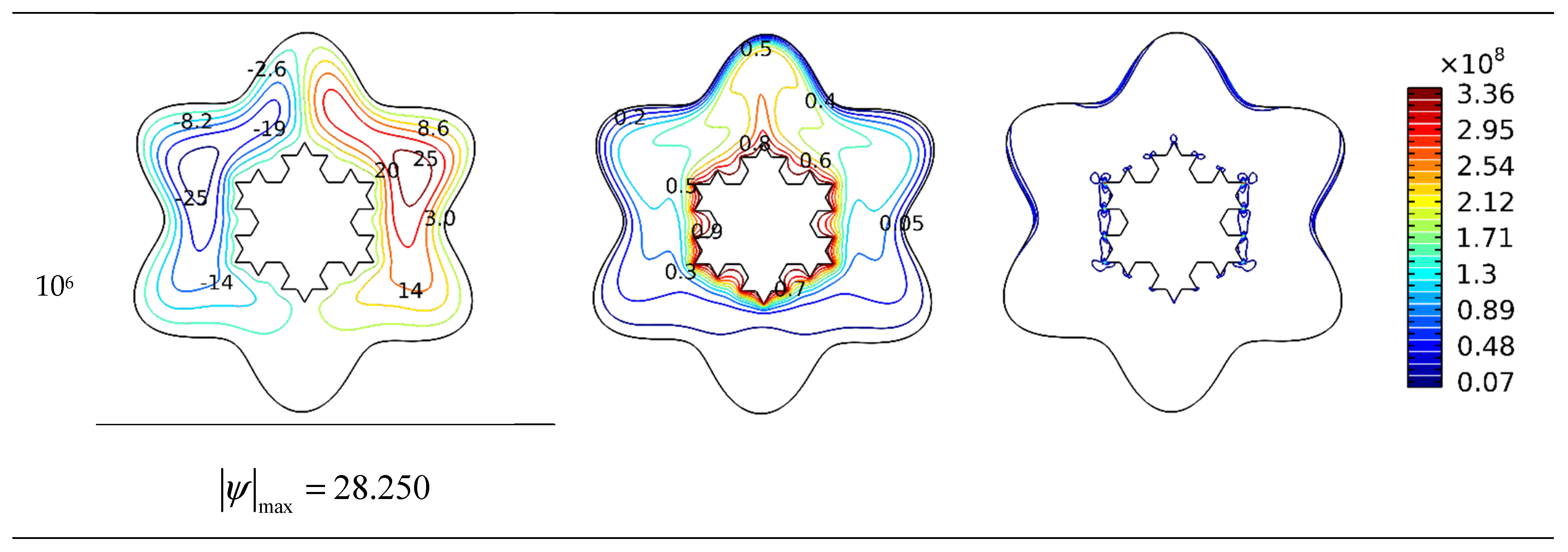

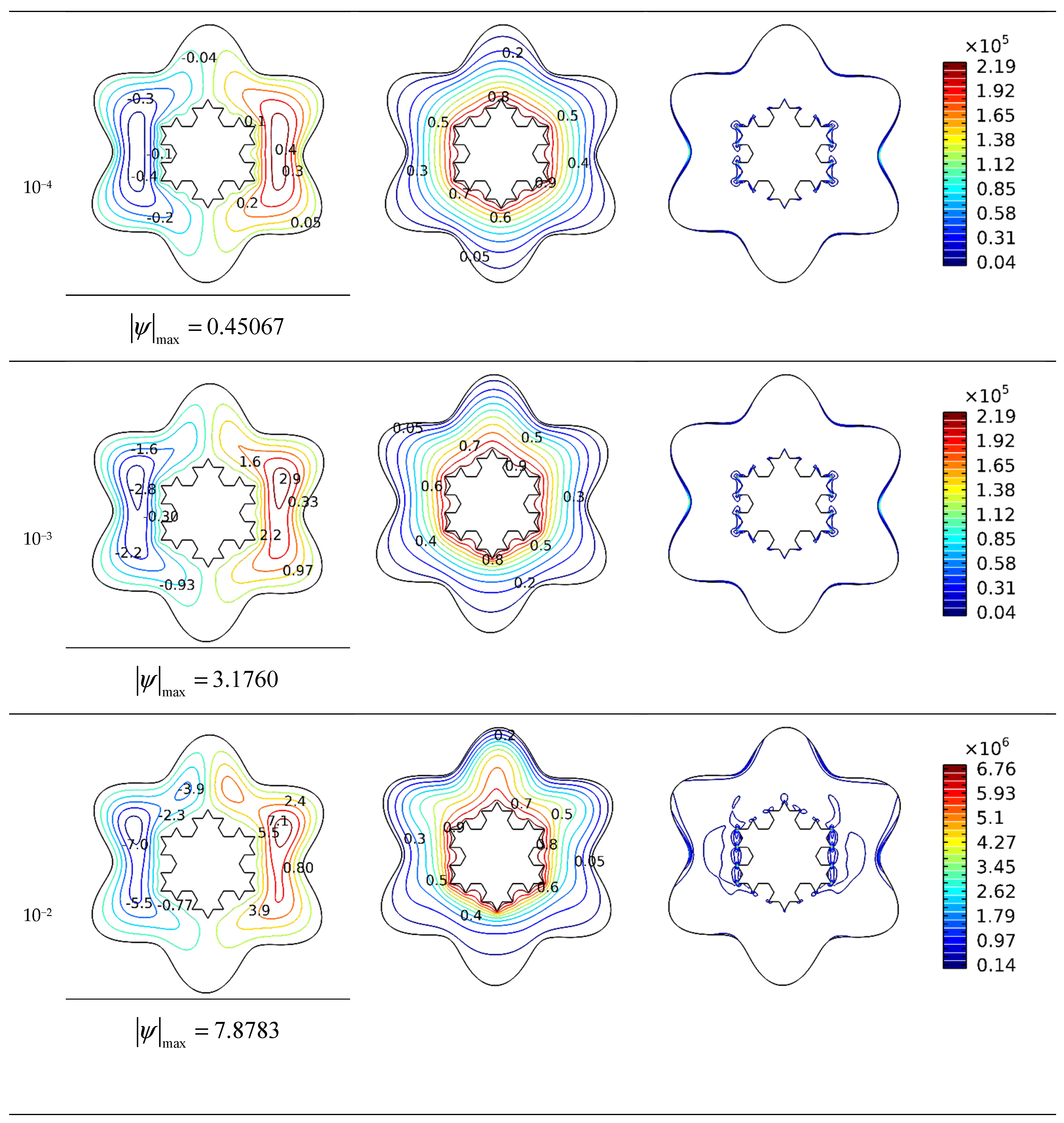

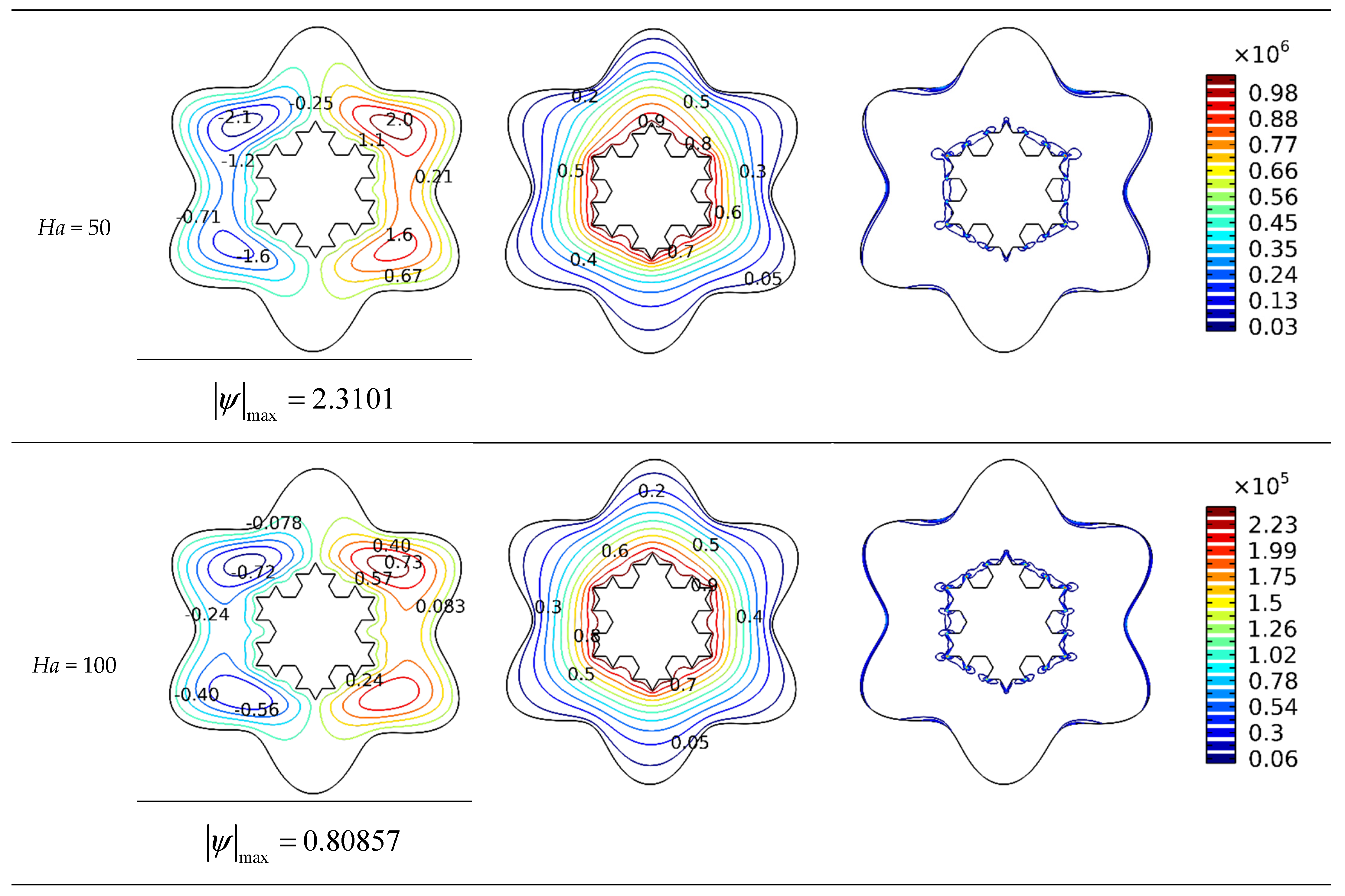
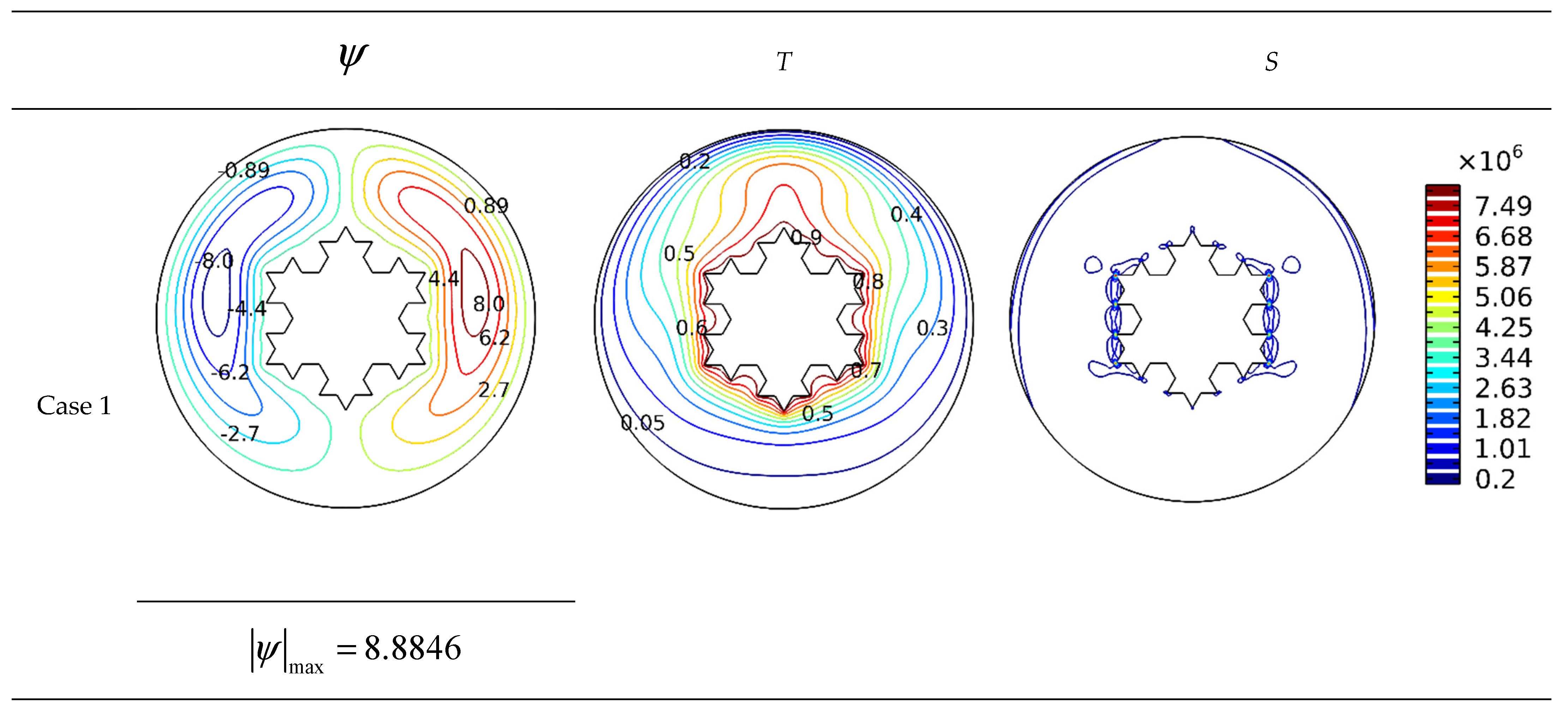
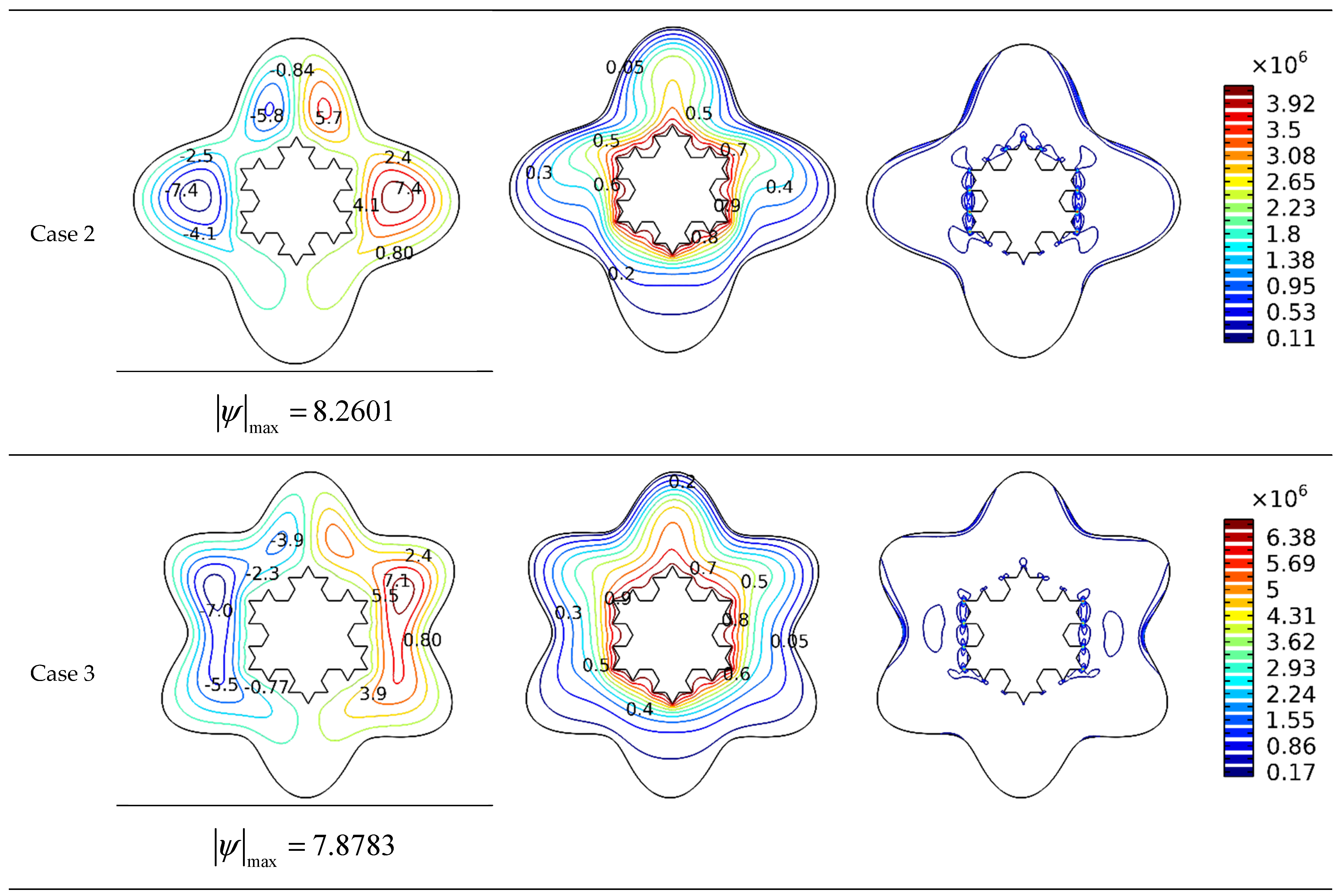
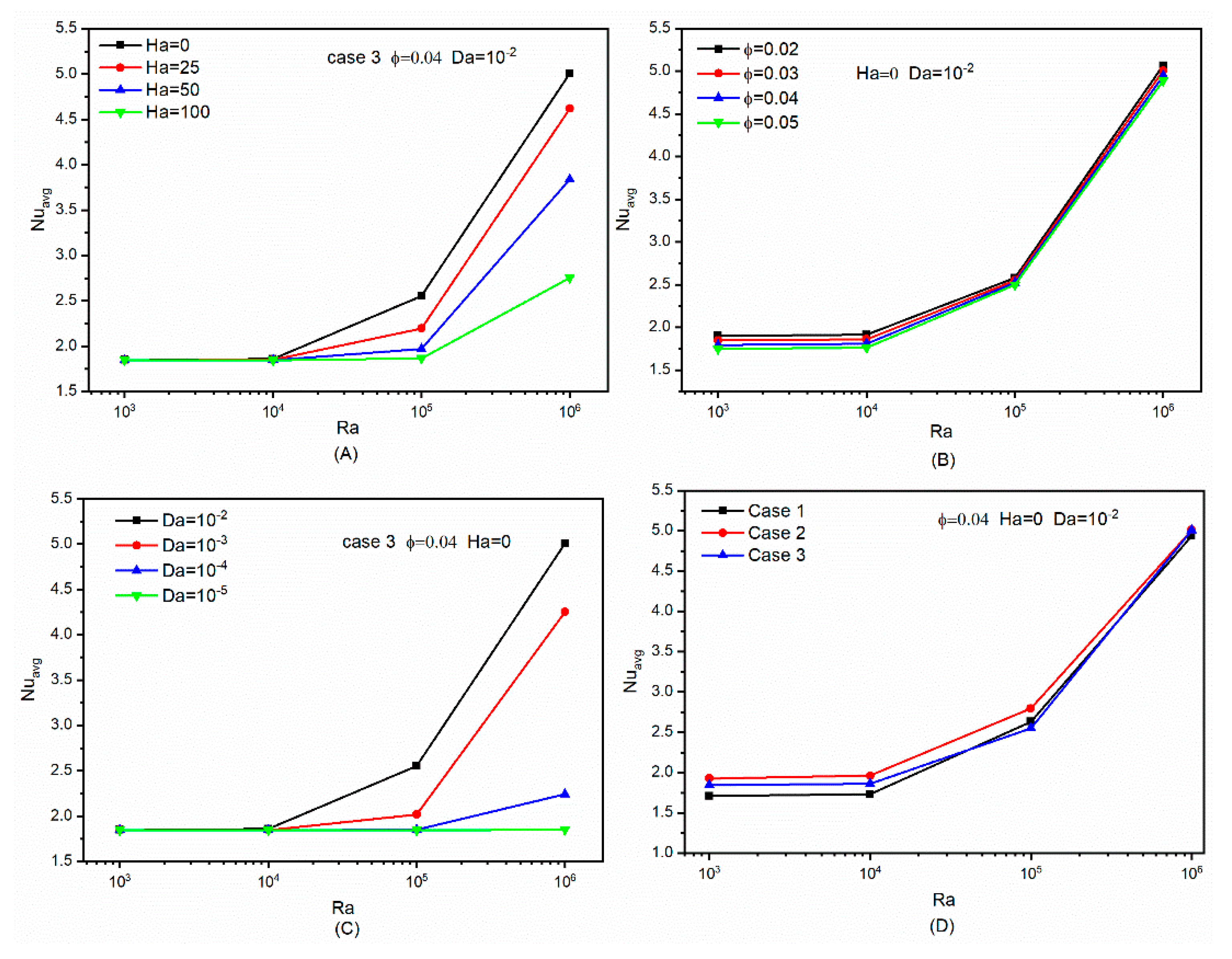
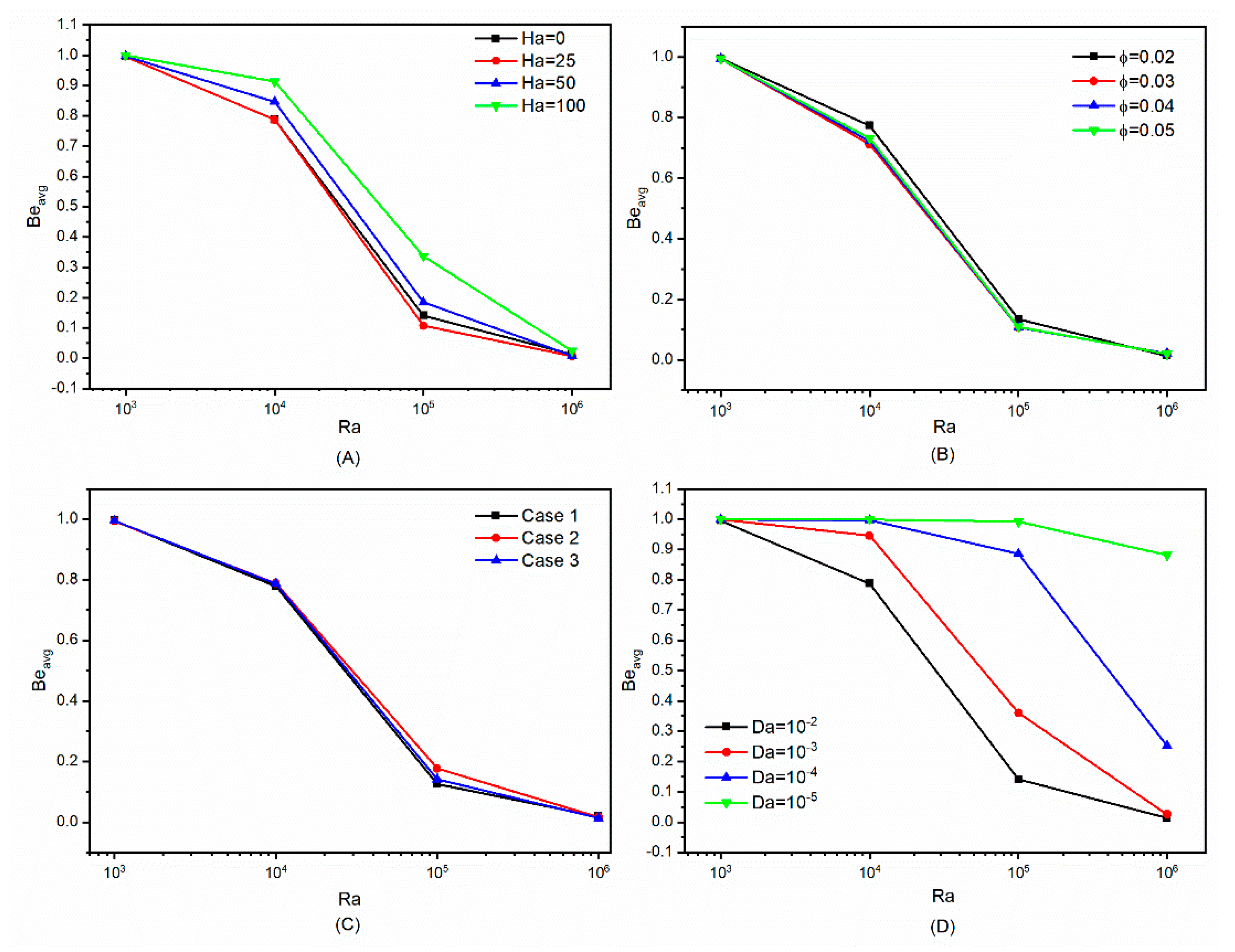
| Properties | Cp (J/kg K) | k (W/m K) | σ (S/m) | β (K−1) | |
|---|---|---|---|---|---|
| H2O (base fluid) | 997.1 | 4179 | 0.613 | 5.5 × 10−6 | 21 × 10−5 |
| Cu (nano-particle) | 8933 | 385 | 400 | 59.7 × 106 | 1.67 × 10−5 |
| Grid Resolutions | 4546 | 6894 | 17,038 | 41,378 | 48,264 |
|---|---|---|---|---|---|
| Nuavg | 2.1625 | 2.2460 | 2.4543 | 2.5466 | 2.5503 |
| 7.8165 | 7.8293 | 7.8612 | 7.8768 | 7.8783 |
Publisher’s Note: MDPI stays neutral with regard to jurisdictional claims in published maps and institutional affiliations. |
© 2022 by the authors. Licensee MDPI, Basel, Switzerland. This article is an open access article distributed under the terms and conditions of the Creative Commons Attribution (CC BY) license (https://creativecommons.org/licenses/by/4.0/).
Share and Cite
Mourad, A.; Abderrahmane, A.; Younis, O.; Marzouki, R.; Alazzam, A. Numerical Simulations of Magnetohydrodynamics Natural Convection and Entropy Production in a Porous Annulus Bounded by Wavy Cylinder and Koch Snowflake Loaded with Cu–Water Nanofluid. Micromachines 2022, 13, 182. https://doi.org/10.3390/mi13020182
Mourad A, Abderrahmane A, Younis O, Marzouki R, Alazzam A. Numerical Simulations of Magnetohydrodynamics Natural Convection and Entropy Production in a Porous Annulus Bounded by Wavy Cylinder and Koch Snowflake Loaded with Cu–Water Nanofluid. Micromachines. 2022; 13(2):182. https://doi.org/10.3390/mi13020182
Chicago/Turabian StyleMourad, Abed, Aissa Abderrahmane, Obai Younis, Riadh Marzouki, and Anas Alazzam. 2022. "Numerical Simulations of Magnetohydrodynamics Natural Convection and Entropy Production in a Porous Annulus Bounded by Wavy Cylinder and Koch Snowflake Loaded with Cu–Water Nanofluid" Micromachines 13, no. 2: 182. https://doi.org/10.3390/mi13020182
APA StyleMourad, A., Abderrahmane, A., Younis, O., Marzouki, R., & Alazzam, A. (2022). Numerical Simulations of Magnetohydrodynamics Natural Convection and Entropy Production in a Porous Annulus Bounded by Wavy Cylinder and Koch Snowflake Loaded with Cu–Water Nanofluid. Micromachines, 13(2), 182. https://doi.org/10.3390/mi13020182








